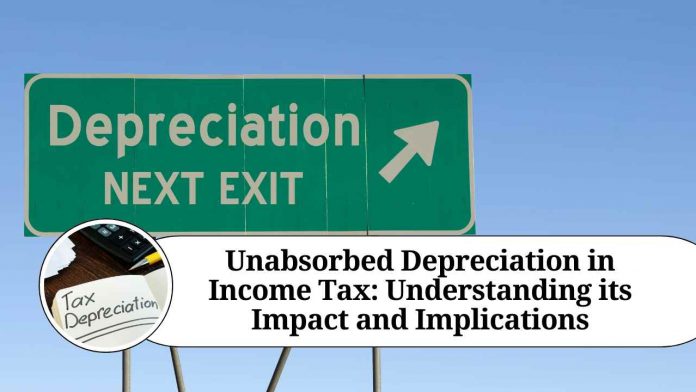Introduction
In the realm of income tax, various components contribute to the determination of taxable income. Depreciation, which accounts for the wear and tear of assets over time, is one such factor. However, in certain situations, the entire amount of depreciation cannot be fully utilized in a given tax year. This unutilized portion is known as “unabsorbed depreciation.” In this blog post, we will delve into the concept of unabsorbed depreciation in income tax, exploring its significance, implications, and how it affects businesses and taxpayers.
Understanding Depreciation:
Before diving into unabsorbed depreciation, it is essential to grasp the concept of depreciation itself. Depreciation refers to the reduction in value of tangible assets used for business purposes. Assets such as machinery, buildings, vehicles, and furniture tend to lose value over time due to wear and tear, obsolescence, or other factors. To account for this decrease in value, businesses can claim depreciation as an expense, which helps reduce their taxable income.
Unabsorbed Depreciation Explained:
Unabsorbed depreciation arises when the depreciation claimed by a business in a particular tax year exceeds its taxable income for that year. In simple terms, it occurs when the total depreciation expense is higher than the profit or income earned by the business in that specific period. Since depreciation is treated as an expense, it helps lower the taxable income, potentially resulting in reduced tax liability. However, when the depreciation claimed exceeds the income, the excess amount becomes unabsorbed depreciation.
Implications for Businesses:
Unabsorbed depreciation can have both short-term and long-term implications for businesses. In the immediate term, businesses may not be able to fully offset their current-year income with the excess depreciation claimed. Consequently, they may have to pay taxes on a higher amount than anticipated. This can impact cash flow and overall financial planning.
However, the unabsorbed depreciation does not go to waste. It can be carried forward to subsequent years for utilization against future profits. This provision helps businesses in the long run as they can offset the unabsorbed depreciation against future taxable income, reducing their tax liability. The carry-forward period may vary from country to country, and it is essential for businesses to understand the specific rules and regulations governing this provision in their respective jurisdictions.
Limitations and Considerations:
While the carry-forward provision offers relief to businesses, certain limitations and considerations must be kept in mind. Firstly, the period for which unabsorbed depreciation can be carried forward is usually capped, typically ranging from 5 to 8 years. After the expiration of this period, any remaining unabsorbed depreciation may become invalid and cannot be utilized further.
Additionally, changes in business structure or ownership can impact the utilization of unabsorbed depreciation. In some jurisdictions, the transfer of ownership or changes in shareholding percentage may result in the forfeiture of unabsorbed depreciation. Therefore, it is crucial for businesses to consult with tax professionals and stay updated on the prevailing regulations to make informed decisions.
Conclusion
Unabsorbed depreciation is an important aspect of income tax, impacting businesses’ tax liabilities and cash flow. It occurs when depreciation claimed exceeds the income earned by a business in a given tax year. While it may lead to immediate tax obligations, the provision to carry forward unabsorbed depreciation allows businesses to offset it against future profits, thereby reducing their tax burden in subsequent years. Understanding the rules, limitations, and considerations surrounding unabsorbed depreciation is crucial for businesses to effectively manage their tax planning and optimize their financial resources.
Read more useful content:
Frequently Asked Questions (FAQs)
Q. What is unabsorbed depreciation in income tax?
Unabsorbed depreciation refers to the portion of depreciation that exceeds the taxable income of a business in a particular tax year. It represents the depreciation expense that could not be fully utilized to reduce the taxable income and, as a result, remains unabsorbed.
Q. How does unabsorbed depreciation arise?
Unabsorbed depreciation arises when a business claims depreciation as an expense, but its total depreciation amount is higher than the income or profit generated in that specific tax year.
Q. Can unabsorbed depreciation be carried forward to future years?
Yes, most tax jurisdictions allow businesses to carry forward unabsorbed depreciation to future years. The unabsorbed depreciation can be utilized to offset taxable income and reduce tax liability in subsequent years, typically within a specified carry-forward period.
Q. Is there a limit on the carry-forward period for unabsorbed depreciation?
Yes, there is usually a limit on the number of years for which unabsorbed depreciation can be carried forward. The carry-forward period varies across jurisdictions but typically ranges from 5 to 8 years. After this period, any remaining unabsorbed depreciation may expire and become invalid for future utilization.
Q. Can unabsorbed depreciation be carried back to previous years?
Carrying back unabsorbed depreciation to previous years is not commonly allowed in most tax systems. However, some jurisdictions may have specific provisions that allow limited backward carry-back of unabsorbed depreciation under certain circumstances. It is essential to consult tax professionals or refer to the tax laws of the specific jurisdiction for detailed information.
Q. How does the utilization of unabsorbed depreciation affect tax liability?
The utilization of unabsorbed depreciation helps reduce tax liability in future years. When a business has taxable income in subsequent years, it can offset the unabsorbed depreciation against the income, resulting in a lower taxable amount and, thus, a reduced tax liability.
Q. Can changes in business ownership or structure affect the utilization of unabsorbed depreciation?
Yes, changes in business ownership or structure can impact the utilization of unabsorbed depreciation. In some jurisdictions, the transfer of ownership or significant changes in shareholding percentage may result in the forfeiture or limitation of the utilization of unabsorbed depreciation. It is important to understand the specific rules and regulations governing such changes in the respective jurisdiction.
Q. Are there any specific reporting requirements for unabsorbed depreciation?
Yes, businesses are typically required to disclose the details of unabsorbed depreciation in their income tax returns. The tax authorities may request supporting documentation and calculations to verify the unabsorbed depreciation amount being carried forward.
Q. Can unabsorbed depreciation be utilized by any type of business entity?
Unabsorbed depreciation can be utilized by various types of business entities, including sole proprietorships, partnerships, limited liability companies, and corporations, depending on the tax laws of the specific jurisdiction.
Q. Can unabsorbed depreciation be carried forward indefinitely?
In most cases, unabsorbed depreciation cannot be carried forward indefinitely. There is typically a defined carry-forward period, as mentioned earlier. However, it is essential to consult the tax laws of the specific jurisdiction to determine the exact limitations and regulations regarding the carry-forward of unabsorbed depreciation.




















